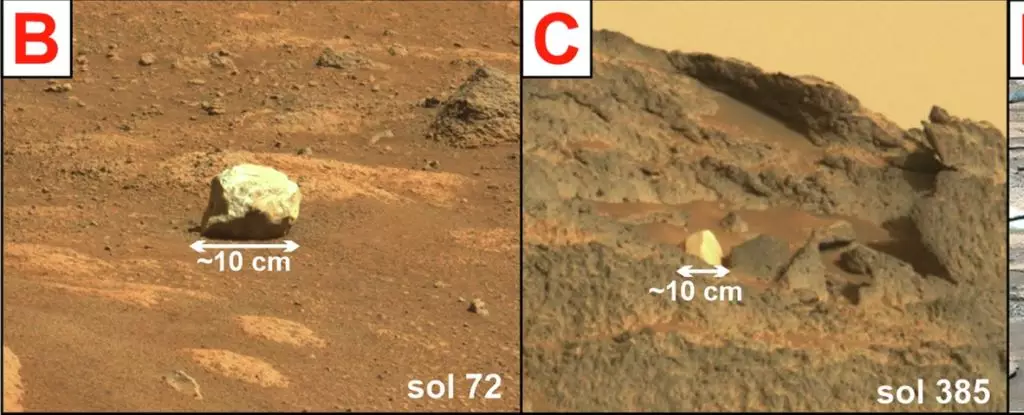Mars has long captured the human imagination. The red planet, with its intricate surface features and eerie stillness, has become a focal point for scientific inquiry and speculation about life beyond Earth. The recent discoveries made by NASA’s Perseverance rover in Jezero Crater have completely reshaped our understanding of Mars, revealing a past that seems far more vibrant than previously believed. As scientists delve into the mysteries hidden beneath the Martian soil, they are uncovering geological formations that challenge our preconceived notions of what sustains life.
Rocks as Time Capsules
The peculiar rocks found in Jezero Crater are not just geological formations; they are time capsules holding secrets about Mars’ history. These pale, sandy stones hint at a wet and possibly warm environment, conditions currently deemed unlikely for the sterile Martian climate. The presence of minerals like kaolinite—a clay that typically forms in wet, temperate conditions—suggests that, at some point, Mars may have experienced substantial rainfall and rich hydrothermal activity. Planetary scientist Roger Wiens emphasizes that these findings are extraordinary for a planet now characterized by cold desolation and arid landscapes.
The term “float rocks” refers to these unusual formations that lie detached from the bedrock, deposited over time via processes like erosion or perhaps even ancient river flows. The context of Jezero Crater enhances the significance of these rocks, as the region is believed to have once housed a large lake—a fact that opens up avenues of exploration into how water once shaped the Martian landscape.
Zap, Analyze, Reveal: The Role of Spectroscopy
The pivotal role of technology comes into play through Perseverance’s Laser Induced Breakdown Spectroscopy (LIBS) instrument. This sophisticated tool enables scientists to analyze the mineral composition of Martian rocks remotely. By vaporizing tiny samples with laser bursts, the LIBS system captures the emitted light to determine the elements present—essentially decoding the rocks’ messages about their origins. Despite the substantial distance from Earth, the insight gained through remote exploration offers a tantalizing glimpse into Mars’ ancient biosphere.
Surprisingly, the kaolinite discovered is not Earth-like; it exhibits differences in hardness and formation that may stem from the unique Martian environment. Such revelations beg the question of what life-sustaining possibilities may have existed in conditions that differ markedly from our own.
Clues about Mars’ Hydrological History
The identification of additional minerals, such as spinel, also adds depth to our understanding of Mars. Spinel, an aluminum-rich gemstone on Earth, raises intriguing questions about its origin and interaction with kaolinite. The amalgamation of these minerals implies that conditions conducive to the formation of life may have existed—conditions where water played a crucial role, maintaining an ecosystem similar in some ways to those on Earth.
This relates directly to one of the most pressing inquiries in planetary science: the history of water on Mars. How much water existed in the past? What has become of it? Understanding the water cycle on Mars is essential, as it directly influences the planet’s potential habitability. The kaolinite found in Jezero Crater may retain significant amounts of water within its mineral structure, which could further inform scientists about the planet’s climatic evolution.
Broader Implications for the Search for Life
The implications of these findings extend far beyond mere curiosity about Mars. They make a compelling case for the potentiality of life on other planetary bodies. If Mars once harbored conditions similar to those that favor life on Earth, it opens up an array of possibilities about where else we might look for microbial inhabitants in our solar system and beyond.
The excitement around this discovery isn’t limited to academic circles; the search for extraterrestrial life taps into our primal fascination with the universe. The prospect that Mars was once lush with water invites humanity to rethink the conditions necessary for life and what forms it might take beyond our biosphere.
The Future of Martian Exploration
What lies ahead involves numerous questions begging for answers. Continued exploration by rovers like Perseverance will remain vital for unlocking the secrets kept by the Martian geology. While current technology allows for spectacular advances, the human desire to explore will always drive innovation further. As tools improve and our understanding deepens, the allure of Mars will remain, challenging us to look beyond our world and ponder our place in the cosmos.
With every rock studied, we inch closer to unraveling the intricate tapestry of Mars’ past, and perhaps one day, we will understand whether the Martian soil once cradled simple life forms or if it harbors the building blocks of life that may lead to new discoveries yet to come.

